Can Cannabis Help Treat Migraine Headaches?
Published :
Jun 4, 2019
Categories :
Medical cannabis

Migraine is a potentially debilitating form of headache that can last for days. Cannabis is showing some real potential as a future treatment for the condition. Let's explore the relationship between this unique and promising pairing.
Migraine is a common health condition that affects approximately 1 in 5 women and 1 in 15 men. Some individuals experience migraines on a rare and infrequent basis, whereas others suffer from them multiple times per month. Migraines manifest as a moderate to severe headache accompanied by a throbbing or pulsing sensation that occurs on one side of the head. In some cases, migraines are also associated with nausea, vomiting, and sensitivity to sound and light.
Currently, there are no cures for this condition, and painkillers of varying degrees are prescribed to reduce symptoms. However, an alternative treatment may be on the horizon. Cannabis has been reported as a potential migraine reliever, with some scientific studies supporting the claim.
Let’s explore the causes and symptoms of the condition, and see what the science says in regards to cannabis as a potential treatment. Then, let’s take a look at some of the best strains to consume if you happen to experience a migraine.
WHAT CAUSES MIGRAINE HEADACHES?
The exact cause of migraines remains a mystery, but research up to this point suggests they are catalysed by abnormal brain activity that has a short-term effect on nerve signals, neurochemicals, and blood vessels in the brain. At the beginning of a migraine, the level of serotonin drops (a neurotransmitter that regulates mood, sleep, and memory). This can cause a nerve located in the head, known as the trigeminal nerve, to start transmitting pain signals. This shift in brain activity also doesn’t have a clear mechanism, but genetics are believed to play an important role.
As well as having a genetic component, migraines are known to be triggered by hormonal, emotional, dietary, and environmental factors. Women are more predisposed than men to experiencing a migraine headache, which is in part due to the hormonal shifts that take place during menstruation. Fluctuations in oestrogen usually cause migraine symptoms to occur around two days before and three days after menstruation.
Extreme emotional states can also cause a shift in brain activity that can lead to migraine. Feelings of intense stress, anxiety, tension, depression, and excitement can induce the condition. Physical states such as tiredness, neck and shoulder tension, jet lag, low blood sugar, and sleep deprivation can also increase the risk of migraine headaches.
Dietary factors such as dehydration and alcohol use, and environmental factors such as bright lights and loud sounds, can also bring about a migraine. Some people can also develop them after ingesting sleeping tablets and contraceptive pills.
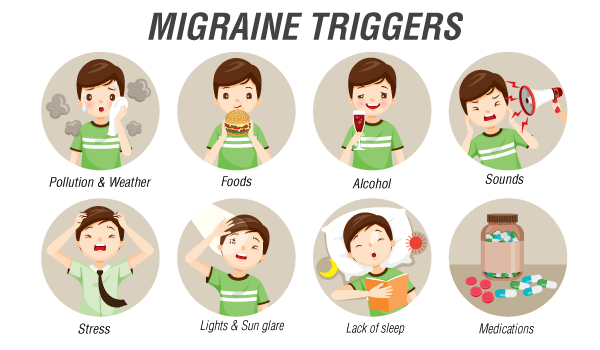
THE SYMPTOMS OF MIGRAINE HEADACHES
There are usually several stages to a migraine headache, with pre and post symptoms occurring alongside the main attack. Symptoms that occur before a migraine are referred to as “prodrome”, and can manifest two days before a migraine takes place. Symptoms such as constipation, mood changes, and neck stiffness can occur during this stage.
The next stage is the migraine itself. These headaches can last anywhere from 4–72 hours, with the primary symptoms being head pain accompanied by single-sided throbbing. This can often be experienced alongside sensations of nausea, vomiting, and sensitivity to light. Additional symptoms include sweating, lack of concentration, and abdominal pain.
In some people, migraines are accompanied by a sensation called aura, although this is fairly uncommon. Aura are nervous system symptoms that involve visual disturbances such as flashes. Other aura symptoms include vision loss, pins and needles in the extremities, and speech difficulties.
The end stage of a migraine is referred to as “postdrome”, which can continue for 24 hours following a migraine headache. The symptoms associated with this stage include confusion, dizziness, and weakness.
CAN CANNABIS HELP RESOLVE MIGRAINES?
Cannabis has been used as a medicinal herb for thousands of years, a testament to its effectiveness as part of a timeless pharmacopoeia. Modern science has confirmed the plant's potential for various different health conditions. Several constituents within cannabis, such as cannabinoids THC and CBD, have been shown to be effective against forms of pain, anxiety, and nausea. It just so happens these symptoms are all associated with migraine headaches.
Numerous scientific studies have been conducted in attempt to investigate the effectiveness of cannabis against migraines. A publication within the journal Pharmacotherapy examined the effects of medical marijuana on migraine headache frequency in an adult population.
121 adults who were recommended conventional treatment alongside medical marijuana by a physician were enrolled in the study. The main outcome of the investigation was to monitor the number of migraine headaches that each subject experienced per month alongside cannabis use. It was found that an average migraine occurrence of 10.4 per month dropped to 4.6 per month, a statistically significant result. The authors of the paper concluded that further research is required to explore the cause-and-effect relationship between the use of different strains and doses to gain a better understanding of how the herb can work to treat migraine headache.
Further research conducted by an Italian research team investigated the effects of cannabinoids as an acute treatment for migraine and cluster headaches. The researches first had to find out what an effective dose of cannabinoids would be for the condition. They found that less than 100mg of a combination of CBD and THC had no effect; however, a 200mg combo of the same formula caused acute pain to be reduced by 55%.
After dialling in the appropriate dosage, the researchers gave a group of 79 chronic migraine patients a daily dose of either amitriptyline, an antidepressant used to manage migraine symptoms, or 200mg of a combination of THC and CBD for a period of 3 months. After this time, the researchers came across an interesting finding: the cannabinoid formula was found to reduce pain intensity in migraine patients by 43.5%. However, only patients who had experienced migraine in childhood experienced these benefits. Those patients who began experiencing the condition later in life experienced no benefits in regards to acute treatment. The researchers concluded that they were able to demonstrate the use of cannabinoids as an alternative migraine treatment, although they appear to only be suited to those with a history of migraines in childhood.
These effects are thought to be the result of how cannabinoids interact with the endocannabinoid system (ECS). The ECS is comprised of a series of receptors (CB1 and CB2 receptors) found on many cell types throughout the body. External cannabinoids such as THC are able to interact with these receptors so efficiently due to an almost identical molecular structure to natural endocannabinoids produced by the body, such as AEA.
A 2019 paper discusses how cannabinoids modulate activity of signalling pathways with a key role in pain control, with clinical findings suggesting that modulation of the endocannabinoid system using both endogenous and exogenous cannabinoids could be relevant to migraine treatment.
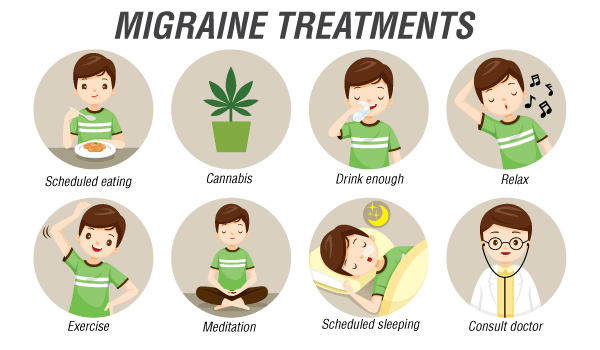
THE BEST CANNABIS STRAINS FOR RELIEVING MIGRAINE HEADACHES
Current research suggests that cannabis may very well be an effective migraine treatment of the future. Many people already use the herb to relieve symptoms associated with the condition. Below are some of the best strains to attempt this with.
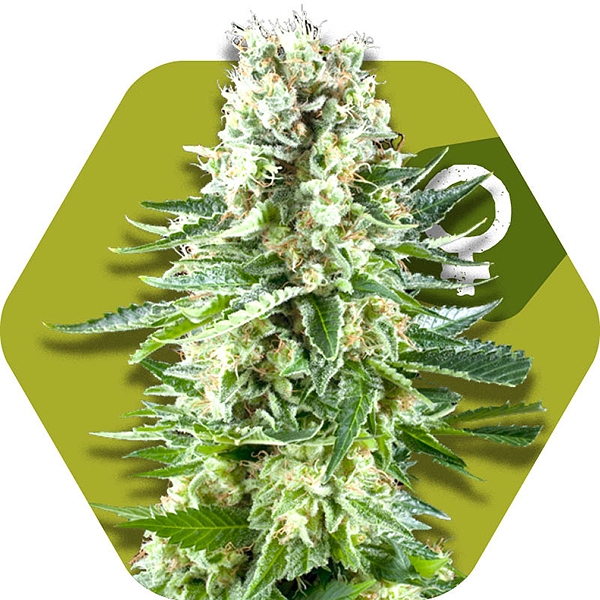 WHITE WIDOW XL
WHITE WIDOW XL
White Widow is one of the most famous cannabis strains on Earth. Its name has weaved its way around cannabis circles, and it is often tied to legends of potency. Zambeza got our hands on these genetics and created White Widow XL, a heavy-yielding version of the strain. This strain provides a balanced high combining uplifting sativa elements with a subtly stoning body high. These effects are therapeutic for some conditions, and may help when it comes to migraine headaches. This soothing high is coupled with scents and smells of spice, sweetness, and sour. A THC level of 18% allows the high to come on fast and linger for hours, a key factor considering how long migraines can last.
White Widow XL grows well both indoors and out. Indoor plants remain at easily manageable heights of 60–90cm and provide a yield of around 600g/m² after 60 days of flowering. Plants cultivated outdoors grow to taller heights of between 150–200cm and provide up to 600g/plant.
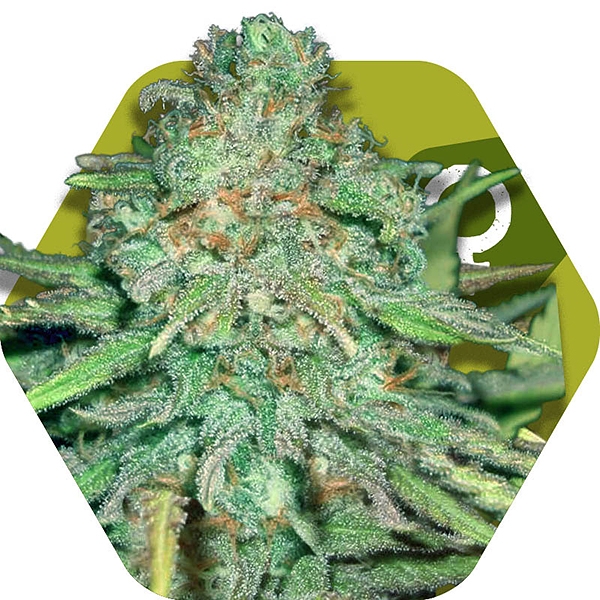 LEMON KUSH
LEMON KUSH
Lemon Kush is a stoning indica-dominant variety created using parent strains Chemdawg, Lemon Thai, and Pakistani Kush. The gentle and relaxing high offered by this strain really hits the spot when experiencing a migraine. Within minutes, tension held within the muscles is released and pain is partially subdued. The therapeutic properties of Lemon Kush may also help some users with accompanying nausea and anxiety. The terpenes within her compact and resinous flowers provide pleasant and stress-busting aromas of fruit and spices.
Lemon Kush is a resilient strain that is easy to grow at home. Indoor plants grow to a maximum height of 130cm and produce 450–500g/m². Plants cultivated outdoors peak at a much taller height of 230cm and produce around 500g/plant. She will be ready to harvest after a flowering time of approximately 55 days.
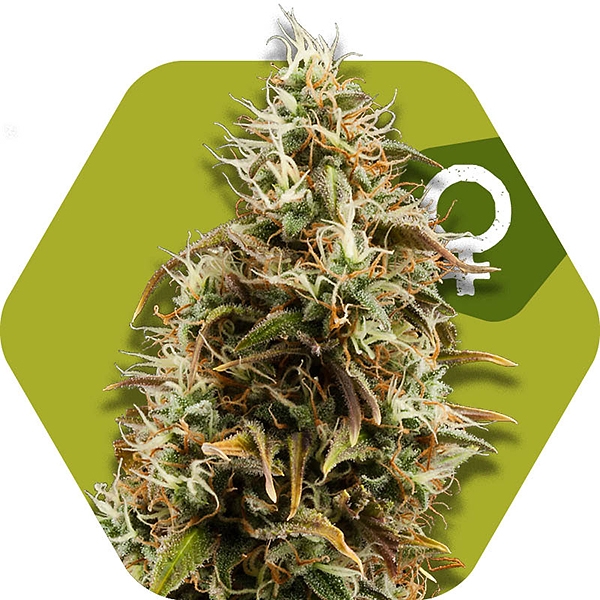 CHOCO CANDY
CHOCO CANDY
Choco Candy is a unique and aromatic strain that was bred to possess a rare trait: smelling and tasting like chocolate. Even her flowers boast a seductive shade of brown reminiscent of the sweet snack. As well as tasting phenomenal, her cerebral sativa high backed by 21% THC provides instant relief against migraine headaches. Each toke of this strain is infused with mouth-watering and refreshing tastes of chocolate and fruit.
Choco Candy grows to around 125cm indoors and provides up to 450g/m² after blooming for 65 days. When grown outdoors, she is capable of reaching 200cm in height and producing up to 500g/plant.
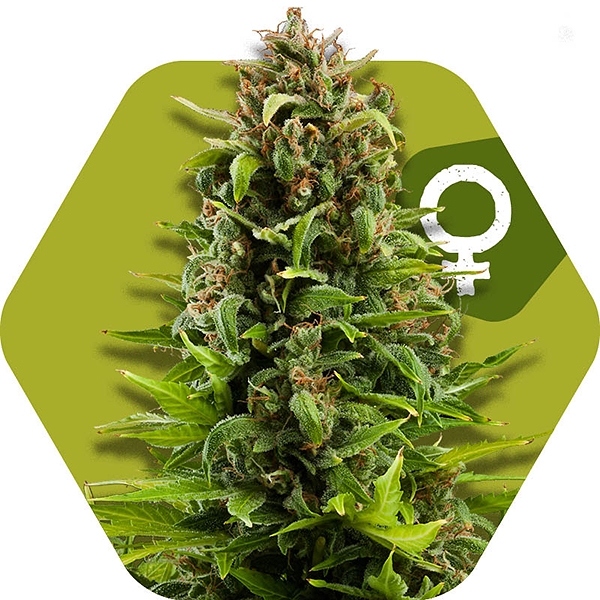 NYC DIESEL
NYC DIESEL
NYC Diesel is a sativa-dominant lady descending from Diesel, Hawaiian, Shiva, and Northern Lights genetics. A few hits from a joint or bong bowl full of these flowers offers a euphoric and mood-elevating high that can counter some of the mood-altering effects of migraines. The high is like a ray of sunshine into the mind, encouraging giggle fits and easing anxiety and worries. Smoking this strain treats the user to flavours and aromas of bitter lemon and diesel.
Indoor plants will yield around 475g/m² after a flowering period of 65 days. Outdoor plants will produce good yields of up to 650g/plant and peak at 190cm in height.






































